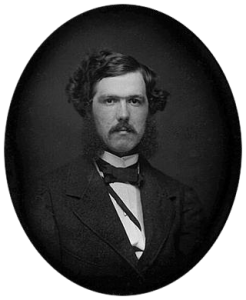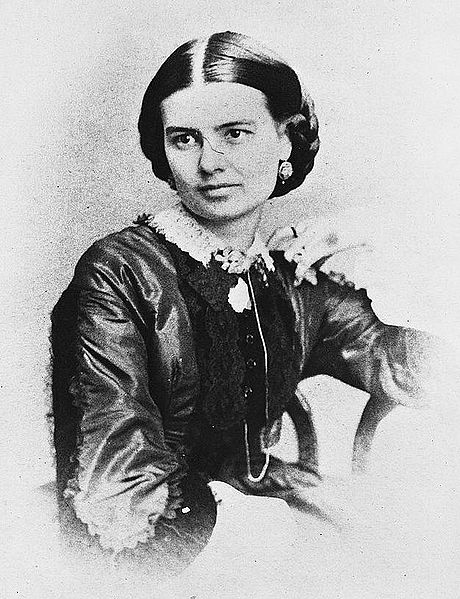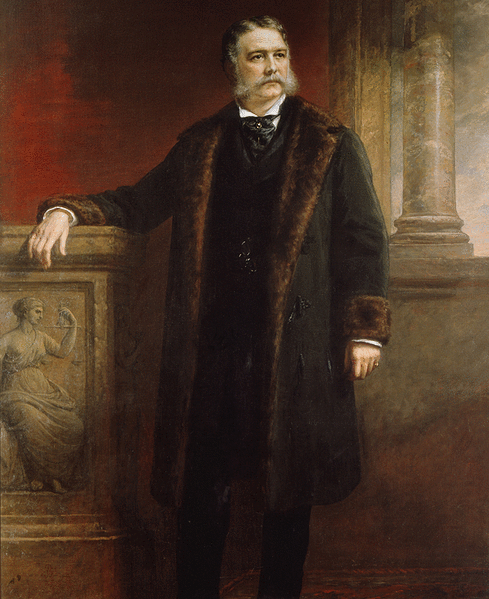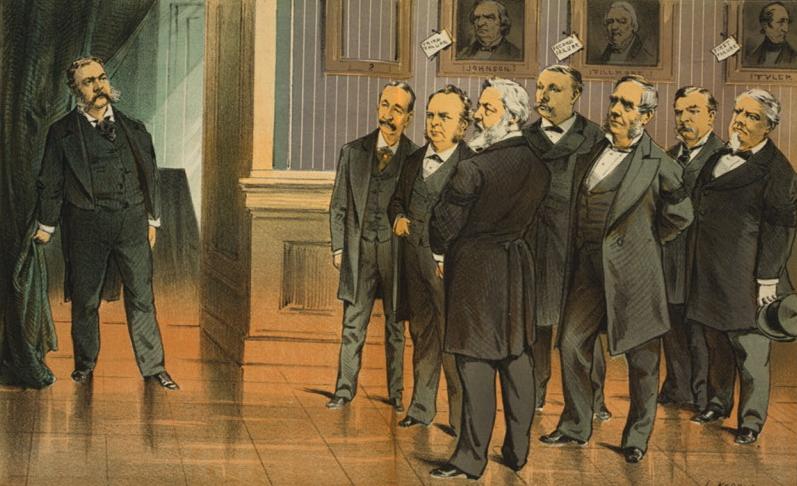| Chester A. Arthur | |
|---|---|
 |
|
| 21st United States President « Previous Next » |
|
| In office | Sep. 19, 1881 – Mar. 4, 1885 |
| Political Party | Republican Party (1854–1886), Whig Party (Before 1856) |
| Personal Info | |
| Born | Oct. 5, 1829 |
| Died | Nov. 18, 1886 (at age 57) |
| Religion | Episcopal |
| School | Union College State and National Law School |
| Profession | Lawyer, Civil Servant |
| Signature | |
| Wife | Ellen Herndon |
| Children | William, Chester, Ellen |
| U.S. Presidents 16-25 | |
| 16. Abraham Lincoln (1861–1865) | |
| 17. Andrew Jackson (1865-1869) | |
| 18. Ulysses S. Grant (1869-1877) | |
| 19. Rutherford B. Hayes (1877-1881) | |
| 20. James A. Garfield (1881-1881) | |
| 21. Chester A. Arthur (1881-1885) | |
| 22. Grover Cleveland (1885-1889) | |
| 23. Benjamin Harrison (1889-1893) | |
| 24. Grover Cleveland (1893-1897) | |
| 25. William McKinley (1897-1901) | |
| List of All the Presidents |
The 21st President of the United States of America, replacing James A. Garfield who was assassinated, was Chester Alan Arthur of New York City. Chester Alan Arthur was known to be a consistent and strong advocate of the Pendleton Civil Service Reform Act, a reform which stated that government jobs should be given to employees on the basis of merit and not by appointment of or relation to people of higher authority.
Aside from the fact that he thought it’s a completely fair system, he believed that it would be the best way to prevent undeserving people from holding important positions in the government, thus preventing future problems that may result from wrong decisions and biased choices. The same reform became the highlight of his administration, and his greatest contribution to the American history.
But no one becomes the President of a country as big and prominent as the United States of America without extensive knowledge and broad life-changing experiences.
The Early Life of Chester Alan Arthur
Chester Alan Arthur was born on the 5th of October, 1829 in Fairfield, Vermont, making him the fifth child of Reverend William Arthur and Malvina Stone Arthur. His interest for public service and politics showed in as early as his childhood years, but he was not the type of kid who was abnormally uninterested in playing pranks and enjoying the good old and short days of being a boy. He did enjoy his playful days. He was home schooled, where he learned how to read and write before 1845 when he entered the Union College as a sophomore and took the traditional classical curriculum and his undergraduate studies.
In his college years, he participated in debates, became a student leader, and supported certain advocacies. He graduated in 1848 and was voted President of Phi Beta Kappa. After college, he then taught school for a couple of years at a town in New York while studying law. He had his goals clear; he has in mind the determination to be a lawyer in the near future and live a wonderful independent life. Finally, in 1854 he passed the bar exam and worked in a prominent legal firm in the New York City.
Life as an Attorney
 Arthur handled and worked mostly with cases concerning the African American community. He won this case about a group of black Americans wanting to free their seven fellows who became slaves in Virginia. It took him quite a long time and he made use of a lot of effort and connections – having trips to the state capital and assisting in arguments in the New York City Supreme Court, but it was all worth it in the end. When he won the case, a lot of different prominent law firms wanted his service, and he gained even more and tighter connections to the best lawyers in New York, and to a number of known and prestigious politicians.
Arthur handled and worked mostly with cases concerning the African American community. He won this case about a group of black Americans wanting to free their seven fellows who became slaves in Virginia. It took him quite a long time and he made use of a lot of effort and connections – having trips to the state capital and assisting in arguments in the New York City Supreme Court, but it was all worth it in the end. When he won the case, a lot of different prominent law firms wanted his service, and he gained even more and tighter connections to the best lawyers in New York, and to a number of known and prestigious politicians.
Another case which was substantial in making the name of Chester Alan Arthur was the case about a black woman who refused to leave the white section of a public vehicle in Brooklyn when she was asked to. When Chester Arthur won the said case and defended the black woman, he earned a lot of money from the public transportation company and from the court. More importantly, he defended the rights of black people and made it a legal agreement never to discriminate black people again in public transportation. Who would not gain support from all these achievements?
Arthur thought of himself as his only competition. He believed that no one can stop him from being successful but himself, and himself alone. He wanted a company and a vast political connection and this aspiration made him join the armed forces. Due to good and fitting records, he was easily accepted and was even appointed to a high position as an engineer-in-chief with a high rank by a Republican governor. Arthur became responsible for giving the soldiers a decent shelter. His housing projects made him deal with a lot of military employees, private service providers and construction services. As expected, his service was of very high quality and efficiency. In companionships like the armed forces, especially in times being the Civil War, being an efficient leader is a must, and a plus. Because of what he has shown, he gained positive reputation for not only his efficient leadership but for his intellectual administration. All of these qualities including reliability brought him to an even higher rank as brigadier general.
Marriage to Ellen Herndon
 In October 1859, at the age of thirty, Arthur married a woman whom he met through his medical student friend from Virginia, when the latter visited his family and relatives. Ellen Lewis Herndon, who caught the eye of the young lawyer and was twenty two at that time, was the cousin of the mentioned medical student friend.
In October 1859, at the age of thirty, Arthur married a woman whom he met through his medical student friend from Virginia, when the latter visited his family and relatives. Ellen Lewis Herndon, who caught the eye of the young lawyer and was twenty two at that time, was the cousin of the mentioned medical student friend.
When Arthur felt successful enough after achieving a lot in the armed forces of the United States, he decided to retire. In 1863, he submitted his retirement which was, even though despised by authorities who definitely liked his service, approved the same year. Chester Alan Arthur made himself busy after such retirement from duty by practicing law and fighting for clients whose concerns were mostly war-related. Everything he did in the past and what he continuously did made him a lawyer dreamt of by many. He gained wealth with his service. Along with this, he worked for United States of America Senator Roscoe Conkling who was then a part of New York Republican Party as well. In 1869, he was the chief counsel to the Tax Commission of New York City and lasted in the service for a year. He received an incredibly high salary in the course of his service.
 For seven years, after his service to the NYC Tax Commission, he was appointed as Collector of the Port of New York in 1871 by the American President at that time, Ulysses Grant. Arthur gained even more wealth in this position as his effectivity served him just as well as it served the New York City. His salary even equaled to that of what a President of the United States receives annually. Consequently, issues on graft and corruption hunted Arthur as his wealth progressed. But there was no clear and reliable evidence, or no evidence at all that he took part of any graft.
For seven years, after his service to the NYC Tax Commission, he was appointed as Collector of the Port of New York in 1871 by the American President at that time, Ulysses Grant. Arthur gained even more wealth in this position as his effectivity served him just as well as it served the New York City. His salary even equaled to that of what a President of the United States receives annually. Consequently, issues on graft and corruption hunted Arthur as his wealth progressed. But there was no clear and reliable evidence, or no evidence at all that he took part of any graft.
In his 6th year of being Collector, however, when President Rutherford Hayes replaced Ulysses Grant in position, Arthur’s relation to Senator Conkling became a hindrance to his continuous good fortune. Since the new president wanted to detach himself from issues of corruption which were inherited from the former administration, he decided to create a team that would investigate the aforementioned corruption. The said team uncovered political favoritism and later questioned salary kickbacks and other actions.
Other arguments and further investigations took place but all finally led to Arthur’s removal from position in 1878. Senator Conkling and Chester Arthur took Hayes’ action as a blatant announcement of conflict and war. Arthur and Conkling then decided to reclaim control over the port of New York and decided to support the reelection of former President Grant.
1880 Elections: Vice President
Many commotions happened; a lot of twists and turns about who will be supported by the Republican Party for presidency. The 1880 elections revolved around the candidacy of Grant, James Blaine, James Garfield and Arthur and the positions they would fill. In the end, it was Arthur who filled the position of vice presidency with James Garfield as the president.
Presidential Office
 In 1881, however, something really unexpected happened. While Arthur was in Albany, President Garfield was shot in Washington by a mentally disturbed man who said that he did it in order for Arthur to be President. In September 19, 1881, President Garfield died and Arthur became an accidental President.
In 1881, however, something really unexpected happened. While Arthur was in Albany, President Garfield was shot in Washington by a mentally disturbed man who said that he did it in order for Arthur to be President. In September 19, 1881, President Garfield died and Arthur became an accidental President.
Arthur served as President for four years, from 1881 to 1885 and it was a good time for America. Historians agree that Arthur was unexpectedly a great president. He was a good administrator, effective leader, efficient, intellectual. As he designed a flag for himself and did other things for a physical presentation of a perfect president, Wayne Morgan said that he liked the appearance of power more than its substance. Aside from his ever famous and important Pendleton Civil Service Reform Act, his contributions include the creation of a new, modernized and improved navy.
In 1886, the world bid goodbye to one of the greatest presidents the United States of America had. He was indeed an inspiration, someone to look up to.